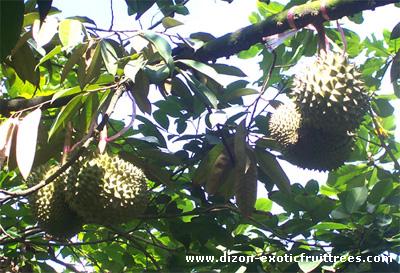|
| Philippine
Dialy Inquirer, Agriculture, Thursday, December 31, 1992 |
|
Durian can be grown, made
productive anywhere in RP
|
|
Multiple rootstock technology
makes this possible
|
|
by Anselmo S.
Roque |
|
|
 Munoz,
Nueva Ecija - Durian, the tree whose fruit is noted for its
distinctive and persistent foul odor but with a heavenly
taste, can now be grown and made productive anywhere in the
country. Munoz,
Nueva Ecija - Durian, the tree whose fruit is noted for its
distinctive and persistent foul odor but with a heavenly
taste, can now be grown and made productive anywhere in the
country.
This assertion was made by Bernardo O. Dizon, a well known pomologist and operator of the UP Bliss Economic Garden in
Quezon City, who said that the perfected use of multiple
rootstock technology makes it possible for the successful
growing of durian outside of Mindanao.
Dizon explained that it is the general belief that the
successful growing of durian is possible in Mindanao,
particularly in Davao, in the country and in such countries
as Malaysia, Indonesia and Thailand. But certain
experiences, he said, have shown that the durian tree can be
grown and made productive in other areas in the country.
He cited the case of Engr. Telesforo Umali who harvests
durian fruits from his fruitful orchard in Quezon City.
In an interview, Dizon said that Chanee Durian is one
imported variety from Thailand which can be grown
productively in different places in the country. Its fruits
weigh up to more than three kilos each and command a higher
price than the native durian. During the fruiting season,
each kilo of Chanee Durian costs P70 while during off season
the cost skyrockets to P700 a kilo.

Durian (Durio zibethinus) is an attractive evergreen
tree with pyramidal to dome shape form. If grown from
seedling, it can grow up to 45 meters in height while from
cultivars the maximum height can be up to 15 meters. Its
fruit is generally believed to have an aphrodisiac effect,
which adds to its popularity among Asians.
"It's a big potential dollar-earner for the country,"
Dizon said as he batted for the popularization of durian
tree growing elsewhere in the country.
He is establishing soon a demonstration area for
high-value fruit trees growing at the Central Luzon State
University here to entice landowners, including farmers, to
have fruit tree growing among their activities. Aside from
durian, he will also showcase the growing of rambutan,
longan, lanzones, oranges and pummelos.
Dizon said durian should be planted with two or more
rootstocks to prevent the attack of root rot disease which
is the number one killer of plants, he said should be
preferred than seedlings from seeds simply because the
latter bears fruit only after 10 years aside from the fact
that they grow tall, they produce less fruits, and are
alternate bearers, (bearing fruit every other year).
Cloned durian with multiple rootstock, he further said,
grows low with well developed lateral branches that even
children can harvest the fruits and there's not much danger
for human beings to be exposed to the hazards of falling
fruits.
During planting of the tree, Dizon advised the planter
to dig one-half cubic meter and change the soil with sandy
loam or in case of clay or heavy soil, add sand and organic
matter. In flat areas, he said, elevate the bade of the
durian tree by one-half to one foot high to prevent the
roots from the effects of waterlogging during heavy rainy
season.
Apply phosphorus fertilizer, he said, at basal
application to encourage more root development and nitrogen
and phosphorus during growth and development of the tree.
Dizon further advised that to make the fruits bigger and
juicier, the grower should apply a combination of nitrogen
and potassium and more of potassium fertilizers two months
before harvest.
The noted pomologist who is a native of Bongabon, Nueva
Ecija and an alumnus of CLSU, said he will schedule a
regular visit to the demonstration fruit tree which will be
established here in cooperation with CLSU president Dr.
Fortunato Battad to conduct free consultation and give free
advice to interested parties. |
|
|

